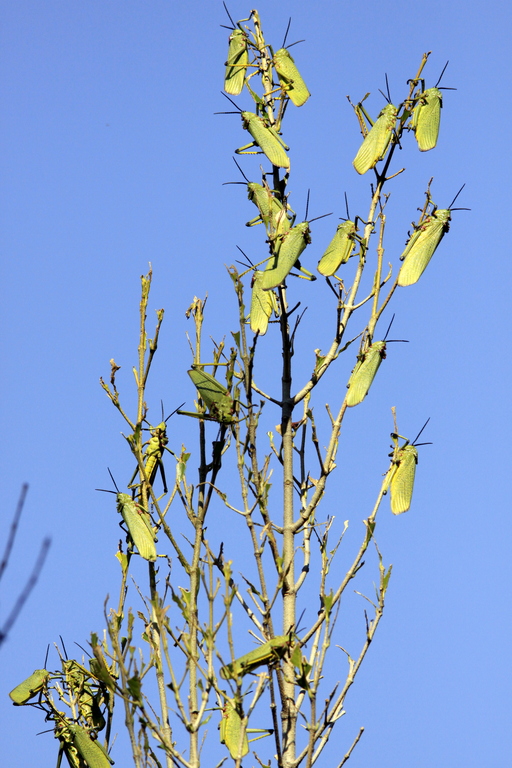
As the world’s attention centres upon the COVID-19 pandemic it is easy to forget that there are many other destructive threats happening to people. There has been another plague taking place. Swarms of locusts have ravaged the Horn of Africa, East Africa and parts of Pakistan and India. Since December, billions of desert locusts have swarmed, devouring fields filled with crops such as maize, millet and sorghum, and stripped bare grazing land, devastating pasture and threatening the livelihoods of tens of millions people who depend on farming and livestock for their survival. It is a race against time as each new generation of the insects reach adulthood and take flight to widen their spread. The United Nations has described the situation as ‘a scourge of biblical proportions’. A square kilometre of the swarm contains 40-80 million locusts and can eat the same amount of food in one day as 35,000 people. An average swarm destroys crops that could feed 2,500 people for a year, the FAO said.
One such swarm sighted in northern Kenya was reportedly 2,400 square km and contained up to 200 billion locusts which descend to feed off plants and vegetation, according to the FAO. A locust consumes their own weight in food every day. The swarms can travel up to 150 km in a day. If left unchecked, their current numbers could grow 500 times by June. Stephen Byantwale, the commissioner for crop protection at Uganda’s ministry of agriculture, said of the fast-breeding insects, ‘They are spreading like wildfire…’
The infestation poses an unprecedented risk to food supplies in an already vulnerable region with high poverty levels, plunging it deeper into crisis. Locusts are eating their way through Djibouti, Eritrea, Ethiopia, Kenya, Somalia, South Sudan, Sudan, Uganda and Tanzania.
In Ethiopia, the locusts have devastated more than 30,000 hectares of crops. Locusts have destroyed over 70,000 hectares of farmland in Somalia. Likewise, Kenya has more than 70,000 hectares of crops under infestation.
The locust plague was the result of recent extreme weather conditions that saw many farmers slowly recovering from three years of drought, which ended in one of the wettest rainy seasons in four decades in parts of East Africa, where floods killed hundreds. Climate scientists suggest that global warming has created the ideal conditions for the insects. The locusts arrived from the Arabian peninsula after cyclones dumped vast amounts of rain in the deserts of Oman – creating perfect breeding conditions.
‘The West Indian Ocean, including the Arabian Sea, was warmer than usual during the last two seasons,’ said the senior scientist of the Indian Institute of Tropical Meteorology, Dr Roxy Mathew Koll, ‘This is largely due to a phenomenon called Indian Ocean Dipole [blamed, too, for Australia’s forest fires], and also due to the rising ocean temperatures associated with global warming.’
Warmer seas led to more cyclones in the Indian Ocean. It was Cyclone Mekunu, which struck in 2018, and then a second cyclone which came to the area that allowed the conditions to continue to be favourable and another generation of breeding, so instead of increasing 400-fold, they increased 8,000-fold which allowed several generations of desert locusts the moist sand and vegetation to thrive in the desert between Saudi Arabia, Yemen and Oman known as the Empty Quarter.
Keith Cressman, locust-forecasting expert for the UN’s Food and Agriculture
Tree full of giant locusts
Organization (FAO), explained, ‘We know that cyclones are the originators of swarms – and in the past 10 years there’s been an increase in the frequency of cyclones in the Indian Ocean. Normally there’s none, or maybe one . . . if this trend of increased frequency of cyclones in the Indian Ocean continues, then certainly that’s going to translate to an increase in locust swarms in the Horn of Africa.’
One piece of perhaps good news is that the (dining) table might be turned on the locusts. The EU is expected to endorse locusts as being safe for human consumption. Christophe Derrien, the secretary general of the industry organisation International Platform of Insects for Food and Feed says, ‘We believe that insects for food is one solution for some of the biggest challenges we are facing on the planet. In the context of scarce resources, and insect production is not too demanding, you have the capacity to produce high-quality protein. That is a very promising solution’ (Guardian, 2 April).
ALJO
From Socialist Standard no-1389-may-2020